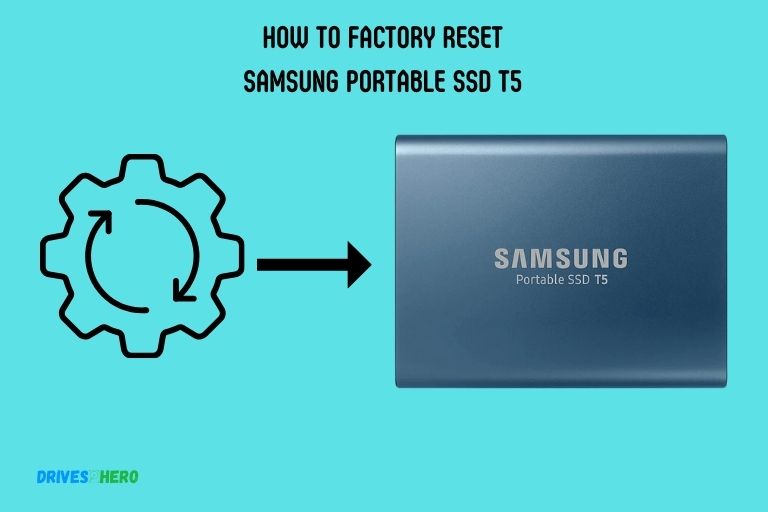How to Factory Reset Samsung Portable Ssd T5? 8 Easy Steps!
A factory reset can be beneficial for various reasons, such as restoring the SSD to its original state or preparing it for a new purpose.
Whether you’re looking to refresh your SSD or prepare it for a new purpose, this step-by-step walkthrough will ensure a seamless reset process.
Follow these easy instructions to return your Samsung Portable SSD T5 to its factory settings, and remember to back up your data before starting.

Key Takeaway
Factory Reset Samsung Portable SSD T5: Step-by-Step Guide
Step 1: Connect Your SSD
Ensure your Samsung Portable SSD T5 is properly connected to your computer using the provided USB cable.
Step 2: Backup Important Data
Before proceeding, back up any crucial data stored on the SSD to prevent data loss during the reset.
Step 3: Open Samsung Portable SSD Software
Launch the Samsung Portable SSD software on your computer. If you don’t have it installed, download and install it from the official Samsung website.
Step 4: Locate Reset Option
Within the Samsung Portable SSD software, find the option for resetting or formatting the SSD. This may be under settings or a dedicated reset tab.
Step 5: Initiate Reset
Click on the reset or format option, and the software will prompt you to confirm the action. Confirm to proceed with the factory reset.
Step 6: Wait for Completion
Allow the software to complete the reset process. This may take a few minutes, and the SSD will be restored to its factory settings.
Step 7: Disconnect and Reconnect
Once the reset is complete, safely eject the SSD using your operating system’s eject option. Disconnect the SSD from the computer.
Step 8: Verify Reset
If needed, reconnect the SSD to your computer and check if it has been successfully reset. You may need to go through the initial setup process again.
By following these simple steps, you can easily factory reset your Samsung Portable SSD T5, restoring it to its default settings.
Understanding The Need For Factory Resetting
Factory resetting a Samsung Portable SSD T5 is essential for resolving performance issues, erasing personal data, and restoring it to its original settings, ensuring optimal functionality.
Reasons Why Factory Resetting May Be Necessary
- Firmware Issues: In some cases, your Samsung Portable SSD T5 may experience firmware-related problems, such as glitches or compatibility issues with your device. Performing a factory reset can help resolve these issues by reinstalling the original firmware.
- Performance Optimization: Over time, your SSD may accumulate unnecessary files, temporary data, or corrupted software. By performing a factory reset, you can clear these unwanted elements, boosting the overall performance and speed of your device.
- Error Troubleshooting: If you encounter frequent error messages or unusual behavior from your SSD, a factory reset can serve as a troubleshooting method. It clears any software conflicts or errors that might be causing the issues.
- Security Concerns: Factory resetting your Samsung Portable SSD T5 can be crucial if you plan to sell or dispose of the device. It ensures that all your data is erased permanently, protecting your sensitive information from falling into the wrong hands.
The Benefits Of Performing A Factory Reset On The Samsung Portable Ssd T5
Performing a factory reset on your Samsung Portable SSD T5 can offer several advantages, including:
- Restoring Original Settings: A factory reset takes your device back to its default settings, undoing any modifications or customizations you may have made. This can be useful if you want to start fresh or if you are facing issues caused by altered settings.
- Resolving Software Conflicts: If your SSD is experiencing conflicts between different software or applications, a factory reset can help resolve these conflicts by removing any conflicting elements. This ensures smoother operation and compatibility with your device.
- Enhancing System Stability: By eliminating unnecessary files and software, a factory reset improves the stability of your Samsung Portable SSD T5. It eliminates clutter and potential sources of errors, providing a clean state for your device to operate efficiently.
Understanding the reasons behind factory resetting your Samsung Portable SSD T5 is crucial for maintaining optimal performance and troubleshooting potential issues.
Whether you need to restore your device’s default settings or resolve software conflicts, a factory reset can help you achieve these goals.
Preparation Before Factory Resetting
Before factory resetting your Samsung Portable SSD T5, it is important to take certain preparation steps to ensure smooth and efficient execution.
This includes backing up your data, disconnecting any external devices, and disabling security features to avoid potential complications during the process.
Before factory resetting your Samsung Portable SSD T5, it’s essential to take a few important steps to ensure a smooth and hassle-free process.
Follow the preparation steps below to make sure you’re ready to proceed with the reset:
Backing Up Important Data Before Proceeding
Backing up your data is crucial before performing a factory reset to avoid losing any valuable information.
Here’s what you need to do:
- Connect your Samsung Portable SSD T5 to your computer.
- Open the SSD’s file explorer and navigate to the files or folders you want to backup.
- Copy the necessary files or folders to a separate storage location, such as an external hard drive or cloud storage service.
- Double-check that all your important data is successfully backed up before moving to the next step.
Checking For Firmware Updates
Checking for firmware updates is an essential step to ensure your Samsung Portable SSD T5 is running on the latest software version.
Follow these instructions to check for firmware updates:
- Connect your Samsung Portable SSD T5 to your computer.
- Open the Samsung Portable SSD Software by double-clicking on the icon.
- Select the SSD from the list of connected devices.
- Click on the “Firmware Update” tab.
- If a newer firmware version is available, click on the “Update Firmware” button to upgrade your SSD’s firmware.
- Allow the update process to complete, and make sure not to disconnect the SSD during this time.
Ensuring The Device Is Connected Properly
To avoid any interruptions during the factory reset process, it’s crucial to ensure that your Samsung Portable SSD T5 is connected correctly.
Follow these steps to ensure a proper connection:
- Check the USB cable for any visible damage or frayed wires. If damaged, replace it with a new USB cable.
- Connect one end of the USB cable to the Samsung Portable SSD T5 and the other end to your computer’s USB port.
- Ensure that both ends of the USB cable are securely plugged in.
- Make sure the SSD is correctly recognized by your computer. You should see it appear as a connected device in your computer’s file explorer or disk management.
By following these preparation steps, you’ll be ready to factory reset your Samsung Portable SSD T5 with confidence and avoid any potential data loss.
Remember to back up your important data, check for firmware updates, and ensure a proper connection before proceeding.
Best Practices For Maintaining The Samsung Portable SSD T5
Maintaining the Samsung Portable SSD T5 is crucial for optimal performance. Learn the best practices, including how to factory reset the device, ensuring smooth operation and preserving data integrity.
Regularly Updating Firmware And Software:
- Firmware and software updates play a vital role in the smooth functioning of your Samsung Portable SSD T5. Keep an eye out for any available updates and install them promptly to benefit from improved performance, bug fixes, and enhanced compatibility with your system.
- Check the Samsung website or use the Samsung Portable SSD Software to easily identify and download the latest firmware and software updates for your T5. Updating your SSD regularly ensures that you can enjoy the most up-to-date features and security enhancements.
Implementing A Backup Strategy To Prevent Data Loss:
- Accidents can happen, leading to potential data loss on your Samsung Portable SSD T5. To safeguard your important files and documents, it’s crucial to implement a backup strategy.
- Consider using a reliable cloud storage service or an external hard drive to back up your valuable data regularly. This way, even if your T5 experiences unexpected issues, you’ll have your files safely stored elsewhere.
Keeping The Device Clean And Free From Physical Damage:
- Proper maintenance of the physical condition of your Samsung Portable SSD T5 is essential for its longevity and optimal performance. Ensure the longevity and optimal performance of your Samsung Portable SSD T5 by keeping it clean and free from physical damage.
- Avoid exposing the device to extreme temperatures, moisture, or direct sunlight. Use a soft, lint-free cloth to clean the external housing of the SSD, gently removing any dust or fingerprints that may accumulate over time.
Remember, by adhering to these best practices, you can maximize the lifespan and performance of your Samsung Portable SSD T5 for seamless data storage and retrieval.
Regularly updating firmware and software, implementing a backup strategy, and keeping the device clean are simple yet effective ways to ensure smooth operation and prevent any potential data loss or hardware issues.
Conclusion
Resetting your Samsung Portable SSD T5 can be an effective solution when you encounter performance issues or want to start fresh.
By following the steps outlined in this blog post, you can ensure a successful factory reset without losing your important data. Remember to back up your files before proceeding, as the process will erase all data on the SSD.
Take note of the unique features of the T5, such as the password protection and encryption options, which can enhance the security of your data.
Whether you’re a tech-savvy individual or a beginner, the user-friendly interface and clear instructions make the factory reset process easy to follow.






